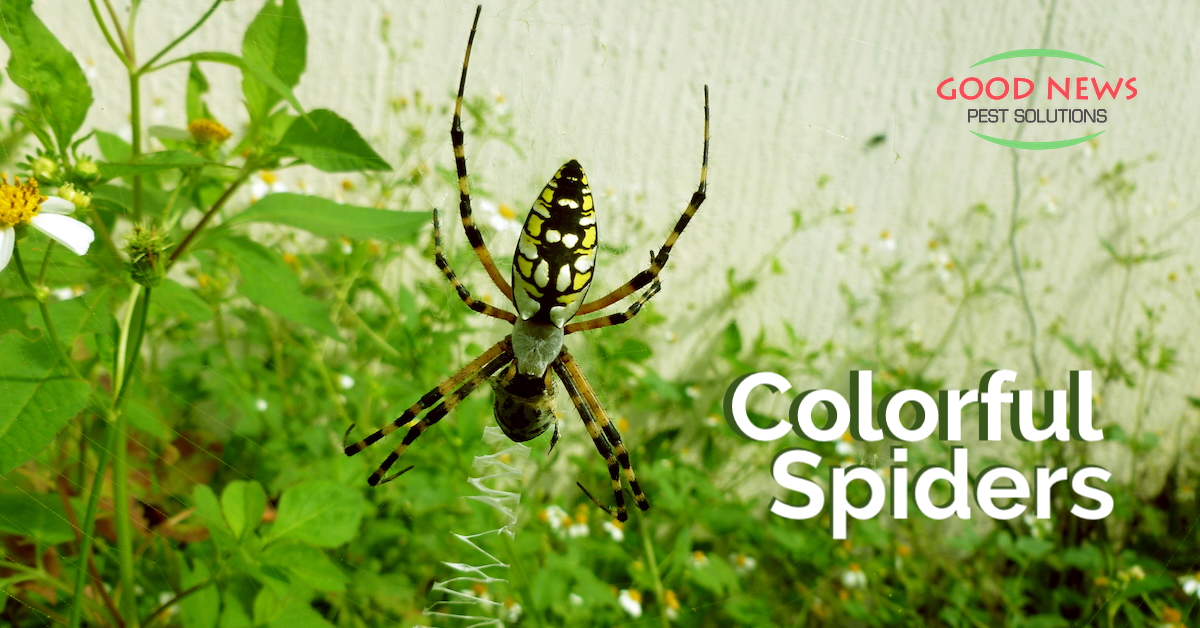
Colorful Spiders
We just can’t talk enough about spiders this month. Many people find them creepy and crawly or downright scary. But the truth is they’re one of the most helpful tiny creatures you can find around the house and in your backyard. And as horror-inducing as some people find these humble arachnids, they come in all manner of vibrant hues and styles.
We know there are more than 50,000 known species of spiders. Some entomologists estimate the so-far undiscovered species could bring the total to nearly 100,000 varieties of spiders. Spiders can live almost anywhere and are found on every continent except Antarctica.
Here in Florida, we have approximately 250 species of spiders, from the small and scurrying type to the venomous Black Widow. Other than the Widow and the Brown Recluse, most spiders in the Sunshine State aren’t a threat to humans, and even those two only cause minor issues with proper treatment. More startling is the wide variety of colorful arachnids we find in our state.
Yellow Garden Spider
Let’s start with the Argiope aurantia, pictured above. The yellow garden spider looks like it belongs at a Stryper concert. Its head and body are mostly white but it has distinctive yellow and black markings on the abdomen. The Latin name roughly translates as "gilded silver-face," and it’s also known as a golden garden spider, writing spider, zigzag spider, zipper spider, or corn spider.
These spiders typically hang out under the eaves on your roof and sometimes in tall vegetation. Besides their look, yellow garden spiders also have an atypical web shape. The center of their thin webs is criss-crossed with zig zag bands of silk. The spider hangs, head down, waiting for prey to land in the web and can oscillate the web when necessary to further ensnare their prey.
Crab Spiders
We’ve talked about some of the many species of crab spiders before. They look just as the name suggests – like tiny crabs. Their front pairs of legs are thicker and longer than the back pairs, and they move sideways like crabs too. These spiders are masters of camouflage – they can look dark brown, almost black to blend on bark, or be bright yellow, orange, pale green, or white when they’re hiding in flowers.
A few species are even more chameleon-like, literally changing color over hours to match their surroundings. Some conceal themselves as bird droppings. The Aphantochilus species can even mimic the ants they feed on.
Green Lynx Spider
Another spider who hunts by hiding and ambushing its prey is the Peucetia viridans. These spiders are bright green with yellow hairy legs (the hair is actually composed of spines). They measure about three-quarters of an inch long and may have some red spots or even a patch of red between their eyes.
The females will lay 25-600 bright orange eggs in an egg sac in September and October and defend those eggs against all threats by spitting a venom their body produces. It can shoot up to a foot away! These spiders are more prevalent in certain parts of the South where they feed on bollworms, cotton leafworms, and cabbage looper moths.
Banana Spiders
Also known as Golden Silk Spiders, Banana spiders like high humidity and wide open spaces. No wonder we run into them – sometimes quite literally – around the Gulf Coast of Florida. They like forested areas along trails. Their orb webs are so widespread in the deep swamps around the Everglades that it may seem like a horror movie setting.
Along with the yellow garden spiders, they are some of the largest non-tarantula-like spiders in North America. You might expect them to be yellowish in color, and some are, but they can have quite a variety of shadings, some of them appearing more red and orange. What’s more often yellow is their spider silk, reflecting an almost metallic gold sheen.
Jumping Spiders
Like crab spiders, there are numerous Florida species that fall under the designation jumping spiders. They are small but notable in their leaping abilities. Jumping spiders also have the best eyesight of any spiders - something that comes in handy for their targeted jumps. They are highly accurate and can catapult distances 20 to 30 times their size.
Think of them like movie stuntmen. Their legs have biological hydraulics that let them jump farther and more accurately than grasshoppers, and they always tether to a silk line. This allows them to brake, stabilize and even start over if they miss their landing. They can also detect sounds up to 3 meters away. Some jumping spiders may boast iridescent blues, bold oranges, bright whites, and translucent browns.
None of these spiders is a threat to humans – not even the ones who spit venom. Although anyone can have an allergic reaction to a spider bite, as long as you get proper treatment, sooner rather than later, you’ll be fine.
But we know regardless of their helpfulness, most people don’t want spiders in their homes, and we’re happy to treat for them. In fact, it’s part of our basic Go Green Perimeter Plus solution. We take care of spiders, roaches, and ants, among other pests, at an affordable price and safe for your whole family. For more details, speak to one of our expert technicians by giving us a call!
« Back to Blog
Proudly Serving
Sun City Center, Ruskin, Palmetto, Parrish, Ellenton, Bradenton, Anna Maria, Holmes Beach, Bradenton Beach, Longboat Key, Lakewood Ranch, University Park, Myakka City, Sarasota, Siesta Key, Osprey, Nokomis, Casey Key, Venice, Englewood, North Port, Port Charlotte, Punta Gorda, Arcadia
Things You Can Do
Pay Your Bill Online
Leave Us a Review
Request a Free* Termite Inspection
Stop Mosquito Bites
Get Rid of Rodents
Get a Termite Damage Warranty
Get Pest Control for Your Attic
Get Pest Control for Your Business Request Prayer
Corporate Address
1080 Enterprise Court, Ste A
North Venice, FL 34275
Call Now: (941) 412-9610
Text: (941) 412-9610
Fax: (941) 412-0080
